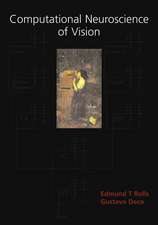The Neurobiology of Memory: Concepts, Findings, Trends
Autor Yadin Dudaien Limba Engleză Paperback – 14 sep 1989
Preț: 616.42 lei
Preț vechi: 864.60 lei
-29% Nou
Puncte Express: 925
Preț estimativ în valută:
117.97€ • 128.09$ • 99.09£
117.97€ • 128.09$ • 99.09£
Carte tipărită la comandă
Livrare economică 12-18 aprilie
Preluare comenzi: 021 569.72.76
Specificații
ISBN-13: 9780198542292
ISBN-10: 0198542291
Pagini: 352
Ilustrații: illustrations
Dimensiuni: 190 x 246 x 24 mm
Greutate: 0.88 kg
Editura: OUP OXFORD
Colecția OUP Oxford
Locul publicării:Oxford, United Kingdom
ISBN-10: 0198542291
Pagini: 352
Ilustrații: illustrations
Dimensiuni: 190 x 246 x 24 mm
Greutate: 0.88 kg
Editura: OUP OXFORD
Colecția OUP Oxford
Locul publicării:Oxford, United Kingdom
Cuprins
THE CONCEPTUAL AND EXPERIMENTAL FRAMEWORK: Some basic notions and their ontogenesis; Paradigms and research tools; Biological universals, and the rationale for a 'bottom-up' strategy; WINDOWS TO MOLECULAR AND CELLULAR MECHANISMS: Cellular and mnemonic devices detected in relatively simple nervous systems: 1. The case of Aplysia; 2. The case of Hermissenda; A cellular mnemonic device in the mammalian brain: long-term potentiation; A different approach: neurogenetics; On the life span of molecules and memories; WINDOWS TO THE ARCHITECTURE OF MEMORY SYSTEMS: On the complexity of internal representations; In search of the topography of engrams; Fragments of engrams and of memory systems in the vertebrate brain; The establishment of innately predisposed representations in sensitive periods: 1. Imprinting; 2. Bird song; The generation of complex internal representations by sensory impressions, and their use: 1. Lessons from monkeys and vision; 2. Amnesias, further clues to our own memories; Epilogue: The integration of levels of biological organization in memory, and the transformation of universal mechanisms to unique experiences; Appendix; Bibliography.
Recenzii
The bibliography is good and the presentation is exemplary. This must be the definitive introduction to the neurobiology of memory.
excellent and readable book ... full marks to author and publisher
excellent and readable book ... full marks to author and publisher















